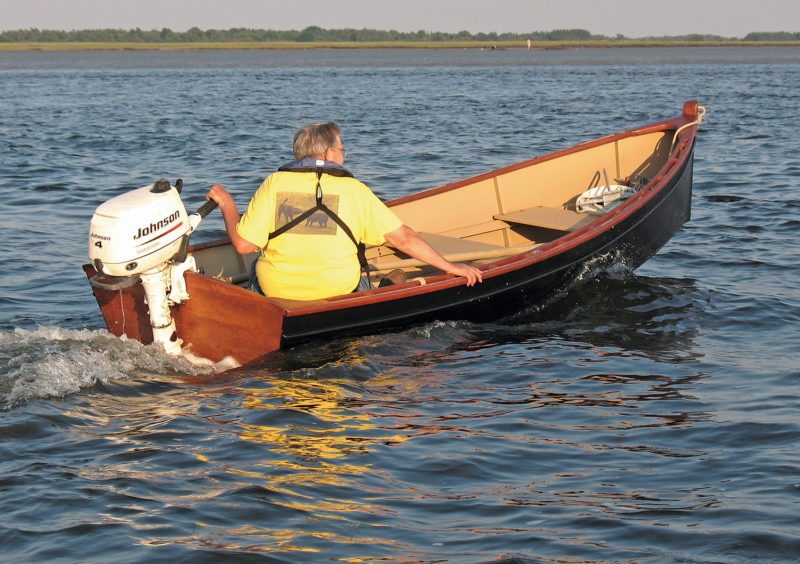 Stan Grayson
Stan GraysonThe Pert Lowell Co. in Amesbury, Massachusetts, designed the Ipswich Bay Skiff for a customer who wanted a lightweight but rugged skiff that he could launch from the beach on a dolly.
Avid readers of Small Boats and WoodenBoat are accustomed to finding articles about flat-bottomed skiffs. There’s a good reason for this: While such boats are sometimes referred to as “humble,” the fact is that once they progress beyond the “flat-iron skiff” of yore—a primitive boat with a totally flat bottom lacking fore-aft upsweep, or “rocker—a skiff can become an elegant solution to all manner of waterborne needs. The more specialized those requirements become, the more the inherent adaptability of such comparatively simple boats tends to shine. The Ipswich Bay Skiff is a case in point.
“One day,” remembered Pert Lowell proprietor Ralph Johnson of how the new skiff came to be, “a customer walked in with WoodenBoat’s article about the Babson Island 14. But he didn’t want as much rocker, and he wanted more sheer [the curve described by the top of hull’s sides]. He had lots of other thoughts as well.”
The prospective buyer, who brought with him two manila folders full of ideas, had very specific criteria in mind. He planned to use a dolly to launch the boat from a sand beach bordering Ipswich Bay and then run it about a mile to his mooring in the Essex River. This meant the skiff would need to be sturdy yet reasonably light and seaworthy, and perform well under outboard power. What’s more, there was a desire for the vintage look of a straight, plumb stem and for some method of stowing a small anchor and rode that would be both neat and secure.
This is a boat that was designed initially not on paper but in three dimensions. “We set up temporary plywood molds,” said Ralph Johnson, a one-time banker who chucked that career to learn boatbuilding from his accomplished father-in-law, Pert Lowell, in Newbury, Massachusetts. “Once we had established where the stem, stern, and midpoint would be, we used a pair of flexible 18‘ battens to try out different curves. We’d nail the battens onto the molds, stand back and judge how things looked, and make adjustments.”
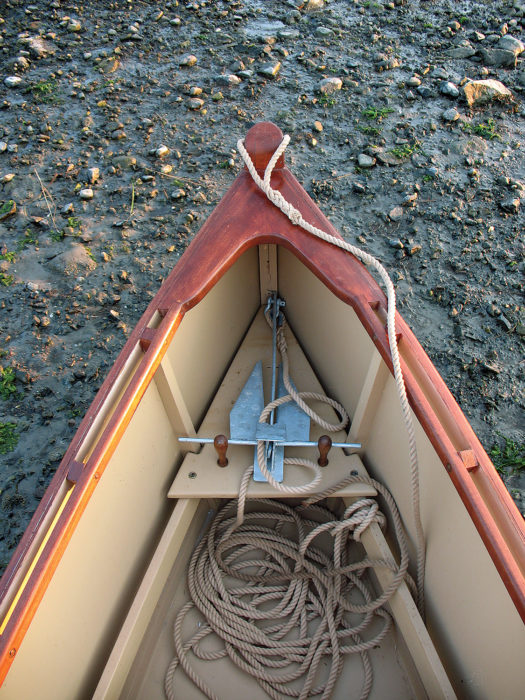 Stan Grayson
Stan GraysonSolid mahogany rails and knees mask the boat’s sheetplywood construction, and several frames add stiffness to the topsides. The anchor stows neatly in the bow,
while the rode lives in a 5-gallon bucket.
Gradually, after 10 or 12 tries, the new skiff’s shape was literally nailed down. A graceful sheer was established that swept down from the bow to provide 15¾” freeboard at its lowest point, making for easy entry and egress, and back up to the 20“ high transom. “There was a lot of talk,” said Ralph, “about how high the sides should be. It’s always a balance of aesthetics and function—keeping people relatively dry, including someone seated on the bow thwart.”
Because the stem is straight and the transom is angled just 13 degrees from vertical, the boat’s waterline is almost as long as possible, contributing to overall speed and performance. The shallow arc of the transom’s top was patterned after that of the Town Class sailboat, the venerable one-design developed at Pert Lowell’s in 1932.
A batten was also used to shape the bottom’s rocker. Aft, the bottom is totally flat to best support the weight of the outboard and deliver solid performance. The hull’s forward sections, however, have significant rocker. “We started out with 5“ and lowered it to 3“, said Johnson. “That proved to be enough.” The rocker provides buoyancy as weight is added, and contributes to a dry ride. The rocker also makes it easy to run the boat onto a beach for a sojourn ashore. A 3“ oak keelson and a sturdy skeg contribute to directional stability.
Sheet plywood was selected as the primary building material because of its strength-to-weight ratio and cost-effectiveness. While opinion varies, Johnson prefers okoume to meranti and especially to today’s fir plywood, which tends to check badly. The bottom is constructed of two standard 8‘-long ½“ okoume sheets scarfed together. The hull sides are scarfed ¼“ okoume. “For structural reasons, I didn’t want all the scarfs to be in the same place,” Johnson said. “The bottom scarf is 8‘ from the stern while the hull sides are scarfed two-thirds of the way forward. It took us about two hours to scarf the panels together.” A sheathing of 10-oz fiberglass cloth set in epoxy covers the bottom and extends 2“ up the hull sides ensuring a leak-free bottom that will withstand a lot of abuse.
The boat was built upside down over the final set of molds. To minimize weight, fir was used rather than oak for frames and chines. All these solid-wood components were sealed with epoxy and received a coat of red lead on their mating surfaces. At the bow, the hull sides are glued and screwed to the tough locust stem. A decorative yet functional “false stem” made of several white oak pieces epoxied together is a visual focal point that also serves as the attachment point for the neatly spliced painter. The bow is reinforced by a precisely fitted fir breasthook. A bronze strip protects the stem against impacts.
The top portion of the stem is stained to match the Philippine mahogany gunwale and inwale, which are secured with copper rivets. “Some small boats,” said Johnson, “are built without inwales, but I don’t think those hulls are stiff enough.” Stiffness and overall strength do not appear to be matters this boat’s owner will ever need to worry about, and Johnson admits that he expects his boats to last a lifetime.
Built into the bow section is a small shelf. A Danforth anchor is stowed here, secured in place to a pair of belaying pins. The latter are among the many wooden hardware offerings—mast hoops, cleats, and so forth—that are a production staple at Pert Lowell, Inc. They’re a nice touch.
At the stern, silicon-bronze screws join the 1¼“-thick mahogany transom to nicely proportioned mahogany knees. The stern thwart, like the others, is built of pine screwed to the thwart risers. Closed-cell Styrofoam flotation is mounted beneath the thwart. The rear thwart is composed of five individual pieces, resulting in a visually interesting seat whose components can be individually removed for refinishing.
My first, and most lasting, visual impression of this boat was that it’s decidedly graceful, but it took me a few minutes to zero in on a subtle detail that helps make it so. Any boat with sheet plywood sides runs the risk of looking slab-sided, no matter how nice its proportions. The Ipswich Bay Skiff, however, has a decorative molding that runs from stem to stern. Echoing the boat’s sheerline, the molding at once contributes to an impression of flowing lines while reinforcing the 19th-century look suggested by the plumb stem.
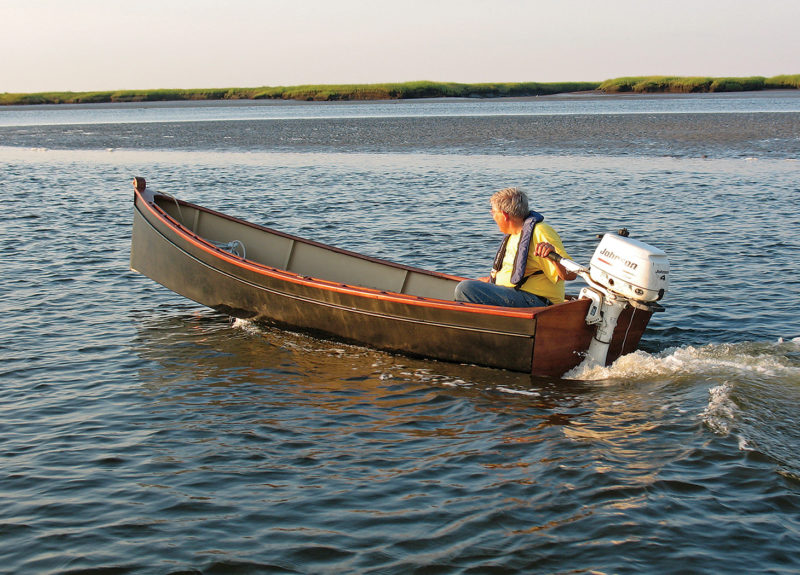 Stan Grayson
Stan GraysonHere, the boat is driven by a 4-hp Johnson four-stroke motor, which is 21 lbs heavier than a comparable out-of-production two-stroke model. There is a price to be paid in boat trim.
These days, anyone buying a boat intended for propulsion by a small outboard confronts the fact that new, small, two-stroke motors have been regulated out of existence. The 4-hp, four-stroke Johnson used for our photo session is quiet and clean, but at 57 lbs it’s a whopping 21 lbs heavier than one of OMC’s comparable, out-of-production, two-stroke models. Because of the negative impact on boat trim and performance, and awkward stresses on one’s wrists and back, it’s unlikely that anything heavier than the already discouraging 55–57 lbs of a new Johnson/Evinrude 4- to 5-hp motor would be acceptable. Manufacturers are making efforts to reduce the weights of their four-stroke outboards, but until the small ones become appreciably lighter, my local outboard mechanic would, I am certain, recommend scouring Craigslist and local outboard shops for a lightly used or reconditioned, long-shaft Johnson/Evinrude 5-hp two-stroke, or something similar.
With Ralph aboard, the 4-hp Johnson made reasonably easy work of tidal current in the picturesque Parker River, and the skiff coped well with a few overly large wakes that rolled beneath her and onto the sand flats and mud banks exposed by an ebbing tide. The boat seems well adapted for two adults, a child, and a dog on a day’s outing, and acceptable for three adults. It’s officially rated to carry 600 lbs, but one would need to give careful thought to packing four adults and their boat bags aboard for anything more than a short trip in protected water.
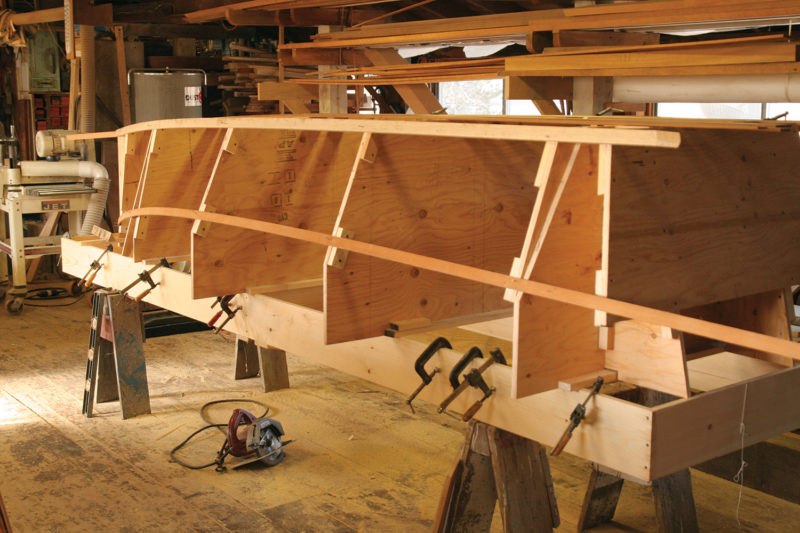 Stan Grayson
Stan GraysonThe Pert Lowell Co. developed the shape of the Ipswich Bay Skiff by first establishing the stem, stern, and ’midship dimensions. The shape was then refined on the building jig, with judgments made by eyeballing battens. The drawings shown here were developed after construction of the prototype, which has a transom inspired by the Town Class sloop (which Pert Lowell builds).
Costing around $4,200 including a careful paint job using marine enamels, this skiff is competitively priced. The Ipswich Bay Skiff is a deceptively simple boat whose several thoughtful details—the stem, the sheer molding, the anchor stowage, the graceful transom, and the multi-part stern thwart—make it an elegant little craft. It’s easily launched and retrieved from a trailer by one person, enhancing its usability—just what’s needed in a small boat. Intelligently handled and maintained, the Ipswich Bay Skiff should give a lot of pleasure.
Oddly enough, given the skiff’s absence of rocker aft, Johnson has found it to be surprisingly pleasant to row. “With one person, it really glides along,” he said. “It would be okay with two or three for shorter distances.” That said, someone looking for a pure rowing skiff would want one designed with that in mind. Altering the bottom configuration would be easy. Boatbuilder Johnson has his battens ready and waiting.
The Pert Lowell website no longer lists the Ipswich Bay Skiff as one of it regular offerings. This Boat Profile was published in Small Boats 2014 and appears here as archival material.
 Stan Grayson
Stan GraysonParticulars:
LOA 13′ 6″
LWL 13′
Beam 4′ 6″
Draft (w⁄o motor) approx 3″
Weight (approx) 160 lbs
Transom height 20″
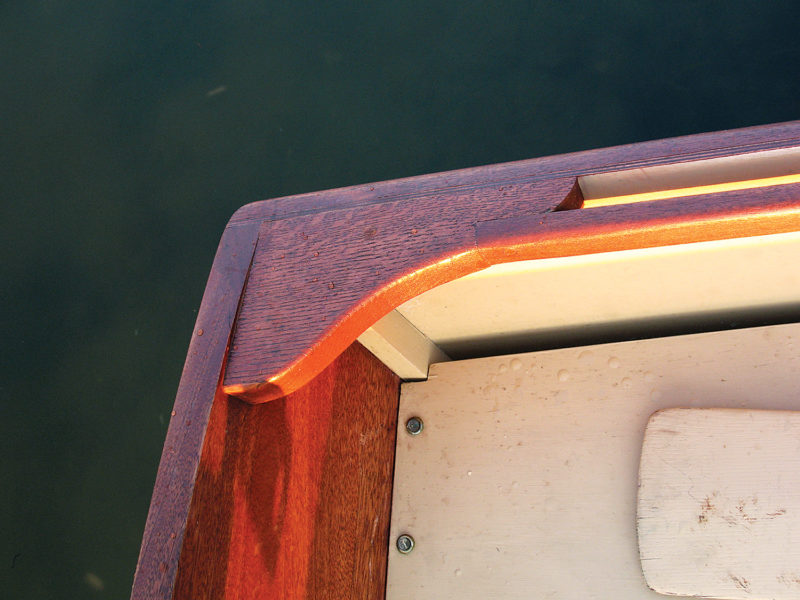
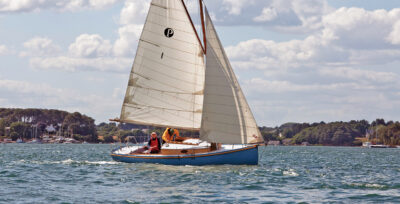
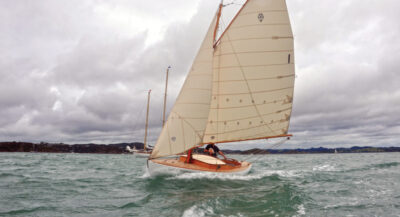
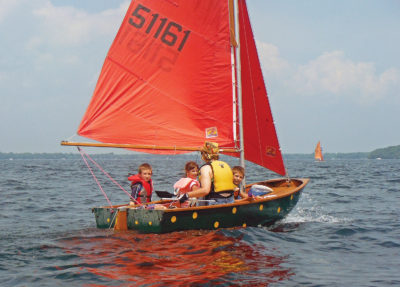
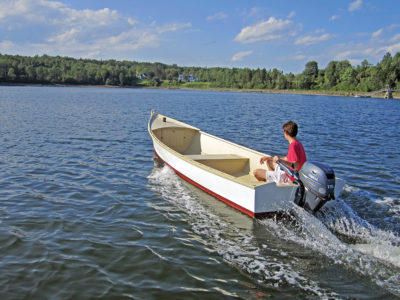
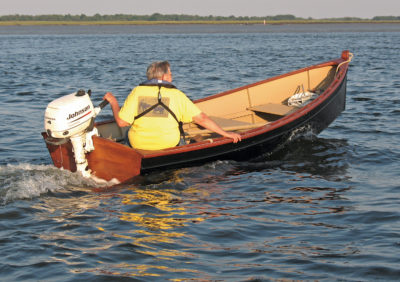
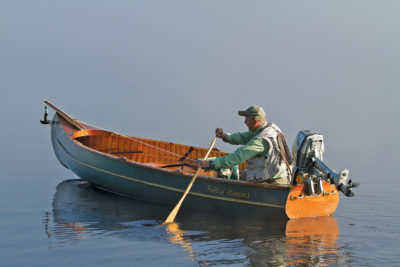
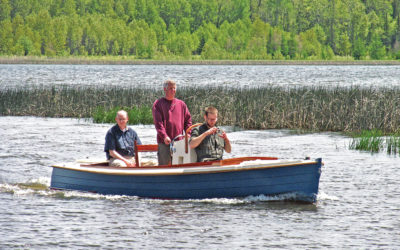
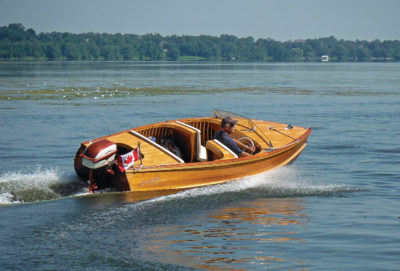
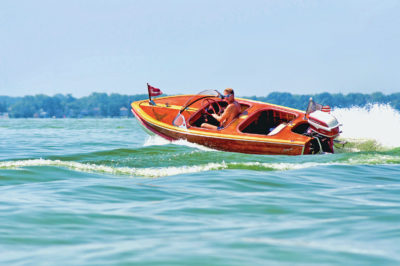
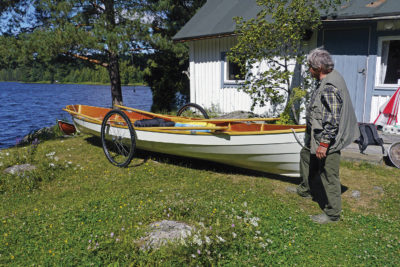
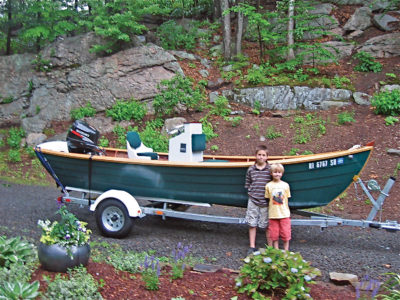
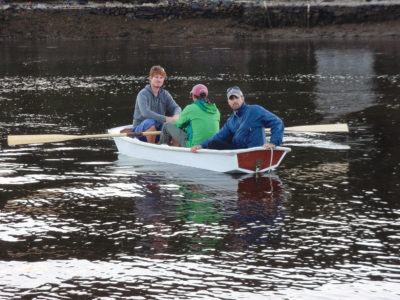
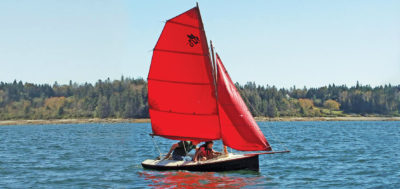
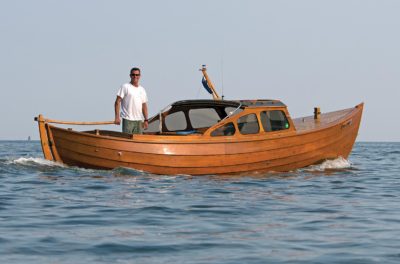
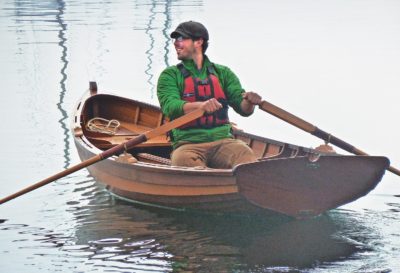
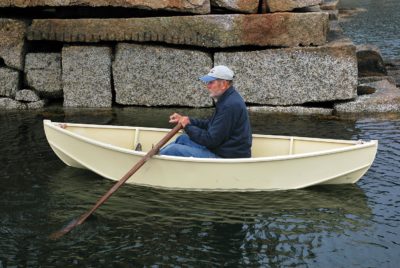
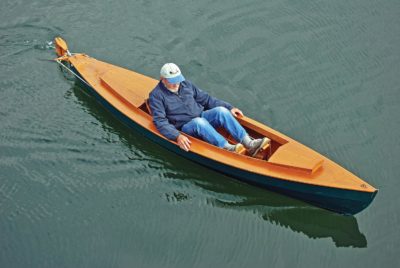
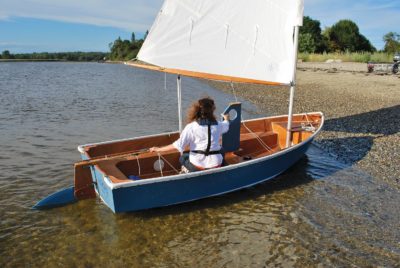
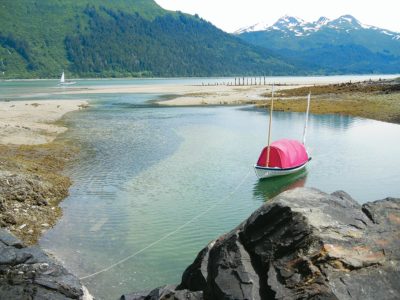
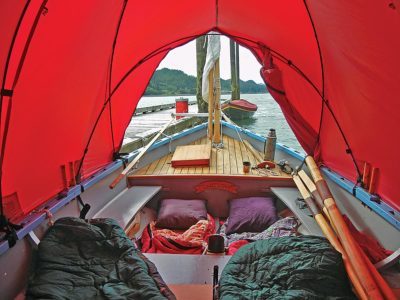
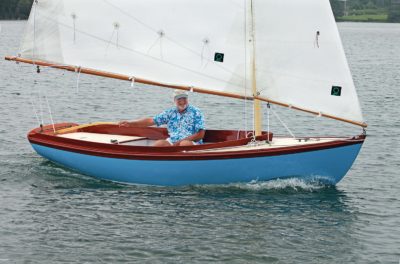
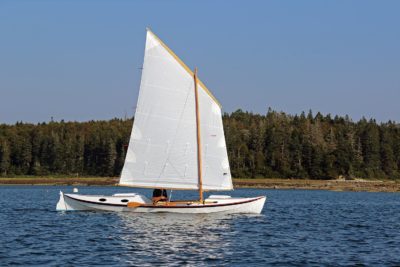
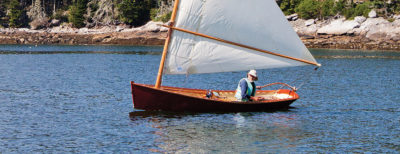
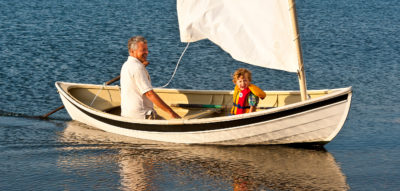
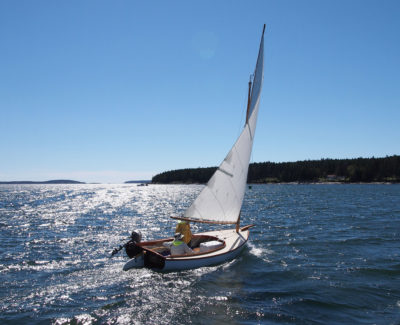
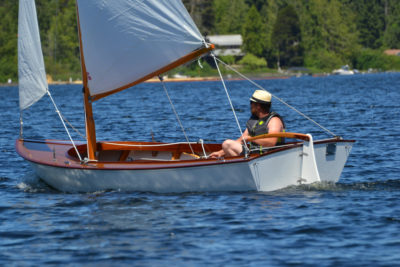

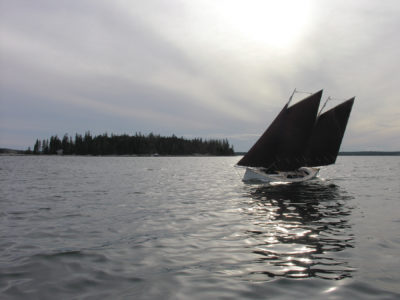
Not an attractive design. Flat bottom and little flare. Narrow sections up front. And as article indicates transom sections are too narrow for the 4-stroke. Very nicely finished example and I’m glad the builder enjoys it.